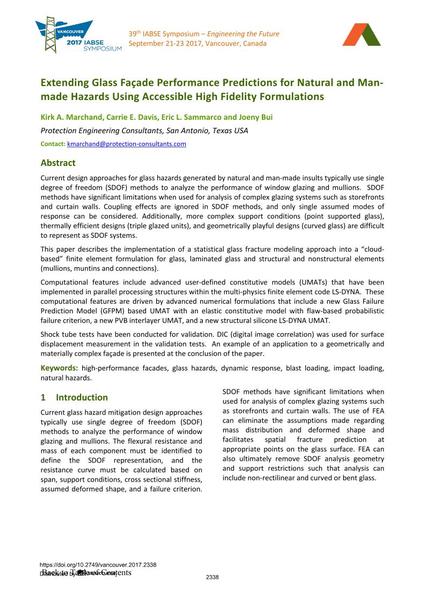Extending Glass Façade Performance Predictions for Natural and Man- made Hazards Using Accessible High Fidelity Formulations

|
|
|||||||||||
Bibliographic Details
| Author(s): |
Kirk A. Marchand
(Abstract)
Carrie E. Davis (Abstract) Eric L. Sammarco (Abstract) Joeny Bui (Abstract) |
||||
|---|---|---|---|---|---|
| Medium: | conference paper | ||||
| Language(s): | English | ||||
| Conference: | IABSE Symposium: Engineering the Future, Vancouver, Canada, 21-23 September 2017 | ||||
| Published in: | IABSE Symposium Vancouver 2017 | ||||
|
|||||
| Page(s): | 2338-2346 | ||||
| Total no. of pages: | 9 | ||||
| Year: | 2017 | ||||
| DOI: | 10.2749/vancouver.2017.2338 | ||||
| Abstract: |
Current design approaches for glass hazards generated by natural and man-made insults typically use single degree of freedom (SDOF) methods to analyze the performance of window glazing and mullions. SDOF methods have significant limitations when used for analysis of complex glazing systems such as storefronts and curtain walls. Coupling effects are ignored in SDOF methods, and only single assumed modes of response can be considered. Additionally, more complex support conditions (point supported glass), thermally efficient designs (triple glazed units), and geometrically playful designs (curved glass) are difficult to represent as SDOF systems. This paper describes the implementation of a statistical glass fracture modeling approach into a “cloud- based” finite element formulation for glass, laminated glass and structural and nonstructural elements (mullions, muntins and connections). Computational features include advanced user-defined constitutive models (UMATs) that have been implemented in parallel processing structures within the multi-physics finite element code LS-DYNA. These computational features are driven by advanced numerical formulations that include a new Glass Failure Prediction Model (GFPM) based UMAT with an elastic constitutive model with flaw-based probabilistic failure criterion, a new PVB interlayer UMAT, and a new structural silicone LS-DYNA UMAT. Shock tube tests have been conducted for validation. DIC (digital image correlation) was used for surface displacement measurement in the validation tests. An example of an application to a geometrically and materially complex façade is presented at the conclusion of the paper. |
||||
| Keywords: |
dynamic response blast loading impact loading natural hazards high-performance facades glass hazards
|
||||
